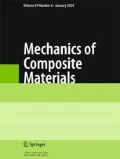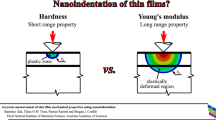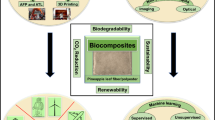Two types of thin impact indicator films were developed: made of an epoxy composite with hollow glass microspheres and of a selfadhesive thermoplastic with retroreflective microprisms. They are highly sensitive to local impacts and change the intensity of light reflection in damage zones. Experimental investigations into the residual strength of a GFRP plate covered with indicator films and resting on a rigid basis after its striking by a steel indenter were performed. Numerical models to predict the imprint diameter on the films and the residual strength of a GFRP plate with defect zones after the impact are developed.











Similar content being viewed by others
References
S. V. Dubinskii, Yu. M. Feigenbaum, A. A. Selikhov, S. A. Gvozdev, and V. M. Ordyntsev, “Mechanisms of realization of impact actions on the wing structure of commercial planes,” Izv. Samar. Nauch. Tsentra RAN, 18/4 (3), the 604-611 (2016).
R. C. Batra, G. Gopinath, and J. Q. Zheng, “Damage and failure in low energy impact of fiber-reinforced polymeric composite laminates,” Compos. Struct., 94, No. 2, 540-547 (2012).
S. A. Smotrova, and A. V. Smotrov, “Features of damageability of aviation structures made from PCM,” Results of Basic Research in Applied Problems of Aircraft Industry, M., Nauka, 418-429 (2016).
S. I. Thorsson, S. P. Sringeri, A. M. Waas, B. P. Justusson, and M. Rassaian, “Experimental investigation of composite laminates subject to low-velocity edge-on impact and compression after impact,” Compos. Struct., 186, 335-346 (2018).
M. Damghani, N. Ersoy, M. Piorkowski, and A. Murphy, “Experimental evaluation of residual tensile strength of hybrid composite aerospace materials after low-velocity impact,” Composites: Part B, 107537 (2019).
A. M. Amaro, P. N. B. Reis, and M. F. S. F. de Moura, “Delamination effect on bending behaviour in carbon-epoxy composites,” Strain., 47, No. 2, 203-208 (2011).
W. Li, C. C. Matthews, K. Yang, M. T. Odarczenko, S. R. White, and N. R. Sottos, “Autonomous indication of mechanical damage in polymeric coatings,” J. Adv. Mater., 28, No. 11, 2189-2194 (2016).
S. Vidinejevs, O. Strekalova, A. Aniskevich, and S. Gaidukov, “Development of a composite with an inherent function of visualization of a mechanical action,” Mech. Compos. Mater., 49, No. 1, 77-84 (2013).
S. Kling and T. Czigány, “Damage detection and self-repair in hollow glass fiber fabric-reinforced epoxy composites via fiber filling,” Compos. Sci. Technol., 99, 82-88 (2014).
S. Shree, M. Schulz-Senft, A. Kuntze, Y. K. Mishra, A. Staubitz, and R. Adelung, “Self-reporting mechanochromic coating: glassfiber reinforced polymer composites that predict impact induced damage,” Eng. Solid Mech., 8, No. 3, 285-300 (2019).
S. Lörcher, T. Winkler, K. Makyła, C. Ouellet-Plamondon, I. Burgert, and N. Bruns, “Mechanical unfolding of a fluorescent protein enables self-reporting of damage in carbon-fiber-reinforced composites,” J. Mater. Chem. A, 2, No. 17, 6231-6237 (2014).
R. Toivola, P.-N. Lai, J. Yang, S.-H. Jang, A. K.-Y. Jen, and B. D. Flinn, “Mechanochromic fluorescence in epoxy as a detection method for barely visible impact damage in CFRP composites,” Compos. Sci. Technol., 139, 74-82 (2017).
S. L. Tchernyshev, M. C. Zinchenkov, S. A. Smotrova, V. M. Novotortsev, and A. M. Muzafarov, “Detection technology of barely visible impact faults of force elements of aviation structures made from polymeric composite materials with the use impact-sensitive polymeric coverings with optical properties,” Konstr. Kompoz. Mater., 4, 48-53 (2018).
S. L. Tchernyshev, M. C. Zinchenkov, S. A. Smotrova, A. V. Smotrov, et al., “A luminescent polymeric film for detection of structural faults,” Patent RU 2644917, (2016).
X. Zheng, Q. Wang, Y. Li, J. Luan, and N. Wang, “Microcapsule-based visualization smart sensors for damage detection: principles and applications,” Adv. Mater. Technol., 5, No. 2, Paper No. 1900832 (2020).
L. V. Chursova, I. I. Sokolov, and A. I. Lyukina, “Development of polymeric syntactic and foam materials of new generation with increased operational characteristics,” Izv. Vuz. Ser. Khimia Khim. Tekhnol., 60, No. 2, 67−73 (2017).
C. Kassapoglou, “Compression strength of composite sandwich structures after barely visible impact damage,” J. Compos. Technol. Res., 18, No. 4, 274-284 (1996).
N. K. Naik and R. Ramasimha, “Estimation of compressive strength of delaminated composites,” Composite Structures., 52, No. 2, 199-204 (2001).
H.-P. Cui, W.-D. Wen, and H.-T. Cui, “An integrated method for predicting damage and residual tensile strength of composite laminates under low velocity impact,” Computers Struct., 87, Nos. 7-8, 456-466 (2009).
P.-L. Vachon, V. Brailovski, and P. Terriault, “Prediction of the propagation of impact-induced delamination in carbon/epoxy laminates,” Compos. Struct., 95, 227-235 (2013).
B. Qi and I. Herszberg, “An engineering approach for predicting residual strength of carbon/epoxy laminates after impact and hygrothermal cycling,” Compos. Struct., 47, Nos. 1-4, 483-490 (1999).
S. Rivallant, C. Bouvet, and N. Hongkarnjanakul, “Failure analysis of CFRP laminates subjected to compression after impact: FE simulation using discrete interface elements,” Composites: Part A, 55, 83-93 (2013).
J. Baaran, L. Kärger, and A. Wetzel, “Efficient prediction of damage resistance and tolerance of composite aerospace structures,” Proc. Institution of Mechanical Engineers, Part G: J. Aerospace Eng., 222, Iss. 2, 179-188 (2008).
A. H. Baluch, O. Falcó, J. L. Jiménez, H. A. H. Tijs Bas, and C. S. Lopes, “An efficient numerical approach to the prediction of laminate tolerance to barely visible impact damage,” Compos. Struct., 225, Paper No. 111017 (2019).
B. Fedulov and A. Fedorenko, “The analysis of the worst-case distribution of the damage in composite material imposed by a low-velocity impact,” Procedia Structural Integrity, 18, 399-405 (2019).
S. Joglekar, M. Pankow, and V. Ranatunga, “A two stage finite element modeling approach to mixed mode delamination in through thickness reinforced composite laminates,” AIAA/ASCE/AHS/ASC Structures, Structural Dynamics and Materials Conf., (2018).
M. R. Abir, T. E. Tay, M. Ridha, and H. P. Lee, “On the relationship between failure mechanism and compression after impact (CAI) strength in composites,” Compos. Struct., 182, 242-250 (2017).
F. Caputo, A. de Luca, R. and Sepe, “Numerical study of the structural behaviour of impacted composite laminates subjected to compression load,” Composites: Part B, 79, 456-465 (2015).
W. Tan, B. G. Falzon, L. N. S. Chiu, and M. Price, “Predicting low velocity impact damage and Compression-After-Impact (CAI) behaviour of composite laminates,” Composites: Part A, 71, 212-226 (2015).
P. Rozylo, H. Debski, and T. Kubiak, “A model of low-velocity impact damage of composite plates subjected to Compression-After-Impact (CAI) testing,” Compos. Struct., 181, 158-170 (2017).
M. V. Zhikharev, S. B. Sapozhnikov, O. A. Kudryavtsev, and V. M. Zhikharev, “Effect of tensile preloading on the ballistic properties of GFRP,” Composites: Part B, 168, 524-531 (2019).
O. Buslaeva and S. Sapozhnikov, “Composite materials with the coating to detect barely visible impact based on the retroreflective film,” Solid State Phenomena., (2020). (in press).
URL: http://e-izol.ru/products (declared 16.10.20)
K. R. Hart, P. X. L. Chia, L. E. Sheridan, E. D. Wetzel, N. R. Sottos, and S. R. White, “Comparison of compressionafter-impact and flexure-after-impact protocols for 2D and 3D woven fiber-reinforced composites,” Composites: Part A, 101, 471-479 (2017).
S. B. Sapozhnikov, Defects and Strength of the Reinforced Plastics [in Russian], Chelyabinsk, Chelyab. Gos. Tekhn. Univ., (1994).
Author information
Authors and Affiliations
Corresponding author
Additional information
Translated from Mekhanika Kompozitnykh Materialov, Vol. 57, No. 1, pp. 69-82, January-February, 2021.
Rights and permissions
About this article
Cite this article
Buslaeva, O.S., Sapozhnikov, S.B., Bezmelnitsyn, A.V. et al. Thin Indicator Films to Assess the Residual Strength of a GFRP after a Local Contact Action. Mech Compos Mater 57, 47–56 (2021). https://doi.org/10.1007/s11029-021-09932-7
Received:
Revised:
Published:
Issue Date:
DOI: https://doi.org/10.1007/s11029-021-09932-7




